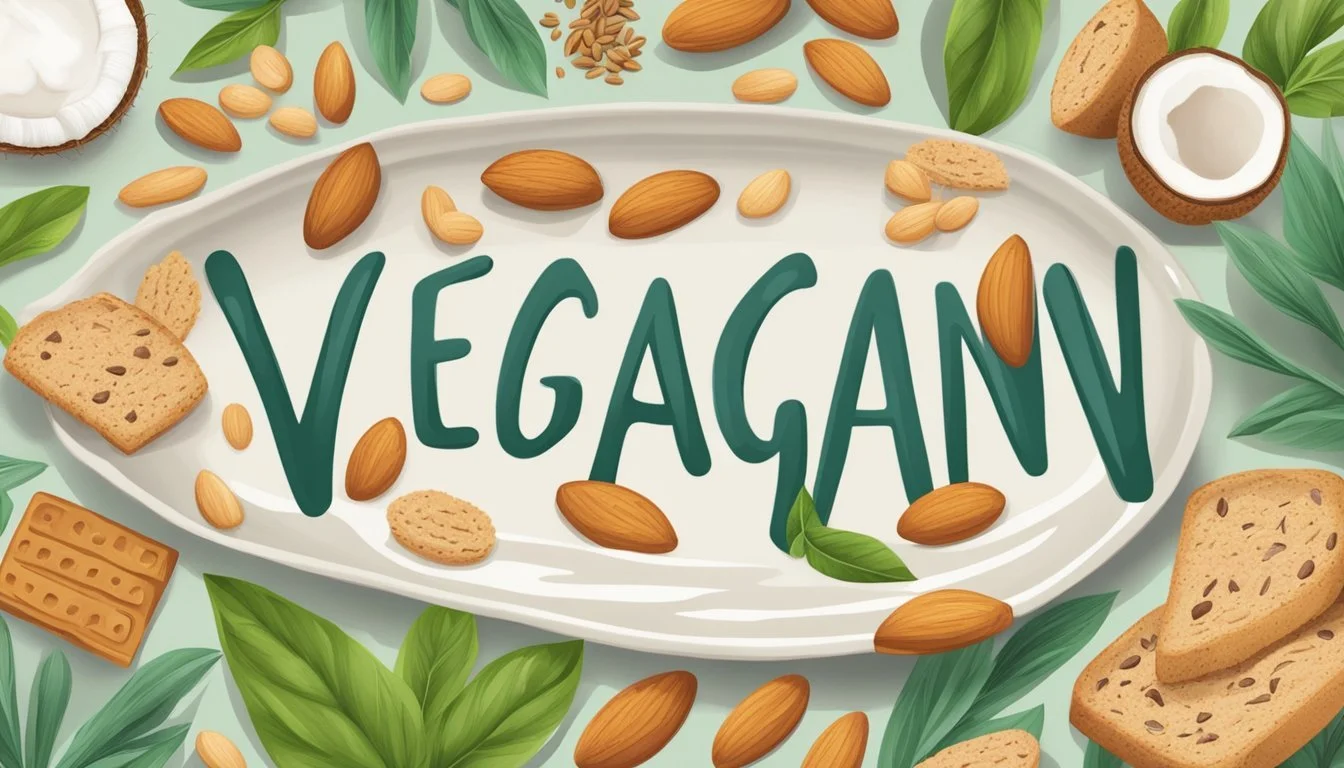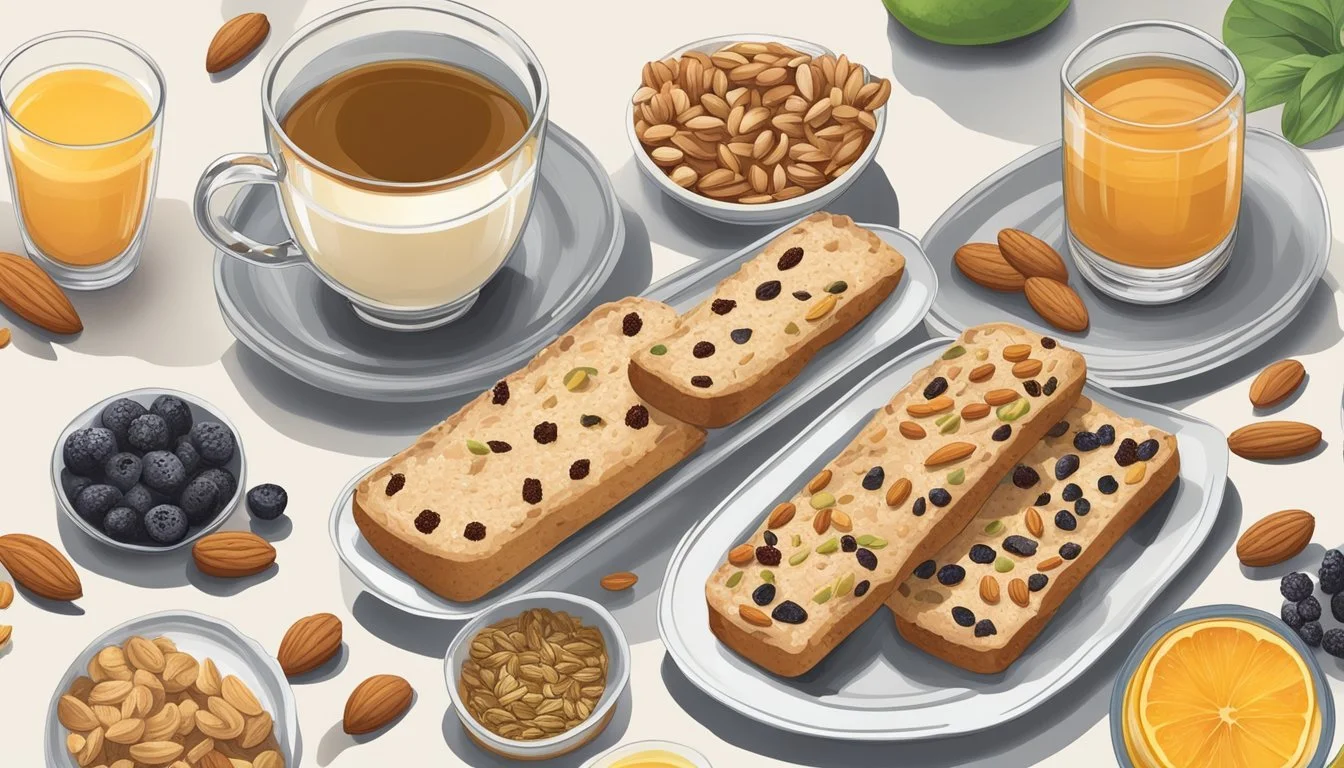Are Biscotti Vegan?
Unveiling the Ingredients and Variations
Biscotti, a traditional Italian cookie known for its hard texture and oblong shape, has garnered a devoted following among those who appreciate its crunch and versatility. Traditionally, biscotti are made using ingredients like flour, sugar, eggs, and nuts, which contributes to their signature dry and crunchy texture that pairs impeccably with hot beverages. However, with the growing demand for plant-based alternatives, the question arises whether biscotti can fit into a vegan diet, which excludes all animal products, including dairy and eggs.
The answer is that biscotti can indeed be vegan, depending on the ingredients used in their preparation. Vegan biscotti swaps out animal-derived ingredients for plant-based alternatives, utilizing creative substitutes to achieve the same crunchy result without compromising on taste. Ingredients such as flaxseeds, aquafaba, or vegan butter can be employed to replace eggs and dairy, creating a biscotti that aligns with vegan dietary principles.
As the interest in plant-based eating continues to rise, many bakers and commercial brands are offering vegan biscotti options, focusing on the inclusion of vegan-friendly ingredients while maintaining the classic characteristics of this beloved Italian cookie. These animal-product-free versions cater not only to vegans but also to those with dietary restrictions such as lactose intolerance or egg allergies, making biscotti a more inclusive treat for various audiences.
Understanding Biscotti
Biscotti, a traditional Italian biscuit, is known for its dry, crunchy texture which makes it ideal for dunking in beverages like coffee or tea. This section delves into the history, ingredients, and defining qualities of biscotti.
History and Origin
Biscotti originated in the Italian city of Prato and date back to the Roman times. They were baked twice to dry them out, which made them perfect for long journeys and storage. Soldiers and travelers often carried biscotti for sustenance.
Traditional Ingredients
Traditionally, biscotti are made using a simple dough composed of flour, sugar, eggs, and nuts — with no form of dairy. This aligns with the ingredients used in many contemporary vegan biscotti recipes.
Defining Characteristics
The two defining characteristics of biscotti are their twice-baked nature and texture:
Twice-baked: They are first baked in a loaf, then sliced and baked again to achieve their characteristic dryness.
Texture: This process results in a biscuit that is ideal for being dipped into coffee or tea, as their crispness and density allow them to absorb liquid without falling apart.
Exploring Veganism
In relation to biscotti, veganism brings a shift in the traditional recipe that eliminates animal products. The impact of this lifestyle on baking is notable, with specific substitutes that enable egg-free and dairy-free variations of these classic treats.
Impact on Baking
The rise of veganism has significant implications for the world of baking. Traditional biscotti recipes include ingredients such as eggs and butter, which are not part of a vegan diet. Vegan bakers replace these items with plant-based alternatives to create dairy-free and egg-free versions of the biscotti. The challenge lies in achieving the same texture and flavor that eggs and dairy products impart. However, vegan baking has made substantial strides, with an array of successful egg and dairy substitutions that cater to the vegan palate without compromising on the indulgent experience biscotti are known for.
Eggs: Used for structure and binding in traditional biscotti, are commonly substituted with flax meals or commercial egg replacers.
Butter: Typically adds richness and aids in leavening, is easily swapped for plant-based margarines or oils.
Common Vegan Substitutes
Vegan baking necessitates a variety of substitutes that mimic the properties of non-vegan ingredients:
Vegan Chocolate Chips: A popular add-in for biscotti, these are made without dairy products, ensuring that chocolate lovers can still enjoy a vegan variant of biscotti.
Non-dairy Milk: Such as almond, soy, or oat milk, is often utilized in recipes in place of cow's milk to add moisture and richness.
Plant-based Ingredients: Items like coconut oil or vegan butter are used in lieu of traditional butter, while nut flours may serve to enhance flavor and texture.
A typical vegan biscotti might include a combination of the following:
Ingredient Vegan Substitute Eggs Flax meal mixture Butter Plant-based butter/oil Dairy Milk Non-dairy milk (almond, soy) Chocolate Chips Vegan chocolate chips
The precision in choosing the right vegan substitutes is key to achieving a final product that stands up to its non-vegan counterpart while aligning with vegan values.
Components of Vegan Biscotti
Crafting vegan biscotti involves selecting plant-based ingredients that mimic the texture and flavor of traditional recipes. The right combination of flours, sweeteners, leavening agents, fats, and flavorings ensures a delicious result that adheres to vegan standards.
Choosing the Right Flour
For vegan biscotti, the foundation begins with flour. All-purpose flour is the most commonly used, providing a balanced structure. For a gluten-free alternative, blends that may include gluten-free flour, cornstarch, and xanthan gum are preferred. They offer the right consistency without the presence of gluten.
All-purpose flour: For a traditional texture
Almond flour: Adds nuttiness and richness
Gluten-free flour blend: Mix with cornstarch and xanthan gum for gluten-free needs
Sweetening Options
The sweet component in biscotti usually comes from sugar. Vegan recipes can use white granulated sugar that is certified vegan or organic to ensure no animal bone char filtering. For depth in flavor, brown sugar can be used, alongside natural sugar alternatives such as coconut sugar.
White granulated sugar: Ensure it's certified vegan
Brown sugar: For a caramelized flavor
Coconut sugar: A less refined option
Leavening Agents
Baking powder is a crucial element that helps the biscotti rise. Always verify that the baking powder is aluminum-free and has no animal-derived ingredients to keep the recipe strictly vegan.
Baking powder: Aluminum-free and vegan-certified
Vegan Fats and Binders
Common fats such as butter are replaced with vegan butter or coconut oil in vegan biscotti. They provide moisture and help bind the ingredients. Some recipes may use flaxseed mixed with water as an egg substitute to aid in binding.
Vegan butter: A dairy-free alternative to butter
Coconut oil: Offers moisture with a subtle coconut flavor
Flaxseed: Acts as a binder when mixed with water
Flavorings and Add-Ins
A range of flavorings and add-ins can elevate vegan biscotti. Vanilla extract and almond extract are popular for their aromatic properties. Nuts such as almonds add texture and nuttiness. Dark chocolate or dark chocolate chips can be included for richness, always ensuring they are dairy-free.
Vanilla extract and almond extract: For fragrance and flavor enhancement
Almonds, other nuts: Provide crunch and nuttiness
Dark chocolate or dark chocolate chips: For a touch of indulgence, ensure dairy-free
Making Vegan Biscotti
Creating vegan biscotti involves carefully selected ingredients and techniques to ensure they are free from animal products while maintaining the classic crispy texture. This section will guide you through the essentials of baking vegan biscotti, from preparation to storage.
Essential Equipment
To start making vegan biscotti, you need some basic equipment: A stand mixer or a sturdy bowl with a hand mixer, a large baking sheet lined with parchment paper for easy removal, and a serrated knife for slicing the biscotti logs. Ensure your baking sheet is large enough to hold the biscotti logs with some room to expand.
Mixing the Dough
Begin by creaming vegan butter and sugar in your mixing bowl until light and fluffy. Then, add vanilla extract to incorporate flavor. In a separate bowl, combine dry ingredients—usually a mix of all-purpose flour, baking powder, and salt. Gradually mix these dry ingredients into the wet ones until the dough forms. It should be cohesive but not overly sticky.
Baking Techniques
Preheat your oven to 350°F (180°C). Shape the dough into logs and place them on the lined baking sheet. Ensure they are spaced apart as they will spread during the first bake. Bake until the logs are firm and lightly golden, which typically takes about 25 to 30 minutes. The goal is to dry out the biscotti enough to become crispy without browning too much.
Slicing and Baking Again
After the first bake, let the logs cool until they are manageable. Using a serrated knife, slice the logs diagonally into individual biscotti, each about ¾-inch thick. Lay the slices cut-side down on the baking sheet. Return them to the oven for another bake, usually around 10 to 20 minutes, flipping them halfway through. This ensures they become crispy on both sides.
Cooling and Storage
Once the biscotti have achieved a nice golden color and crispy texture, remove them from the oven and allow them to cool. They will continue to harden as they cool. Store the finished biscotti in an airtight container to keep them crisp. Properly stored, they can last several weeks, making them an excellent treat for extended enjoyment.
Customizing Your Vegan Biscotti
Vegan biscotti offer a versatile canvas for creative baking, readily accommodating a variety of mix-ins and flavors without compromising the classic texture. Below, find recommended additions to tailor your biscotti to personal tastes.
Incorporating Nuts and Seeds
Nuts add a delightful crunch and nutritional boost to biscotti. Walnuts and pecans contribute a rich, buttery flavor, while pistachios and almonds offer a delicate sweetness and appealing texture.
Preferred Nuts: Walnuts, Pecans, Pistachios, Almonds
Method: Roughly chop nuts and fold into the dough. Use 1/2 cup as a guideline to maintain dough structure.
Using Dried Fruits
Dried fruits introduce natural sweetness and chewiness. Raisins and dried cranberries infuse a tartness that contrasts well with the biscotti's crispness, while dried apricots provide a subtle, fruity aroma.
Optimal Dried Fruits: Raisins, Cranberries, Dried Apricots
Tip: Dice larger fruit pieces and soak briefly in water to soften before adding to the dough.
Chocolate Variations
Chocolate can elevate biscotti from simply satisfying to decadent. Dipping your biscotti in melted chocolate creates a luxurious treat; alternatively, cocoa powder can be added to the dough for a full-bodied chocolate flavor.
Chocolate Options: Chocolate Dipped Biscotti, Cocoa Powder-Infused Dough
Preparation: Dip cooled biscotti in chocolate or add 1/4 cup of cocoa powder to the dry ingredients for chocolate dough.
Herbs and Spices
Herbs and spices can subtly enhance the character of biscotti. A dash of cinnamon warms the overall flavor profile, while orange zest imparts a refreshing citrus note.
Herb and Spice Suggestions: Cinnamon, Orange Zest
Usage: Incorporate 1 teaspoon cinnamon or 1 tablespoon orange zest into dough for a flavorful twist.
Serving and Pairing
Vegan biscotti are a versatile treat that can be perfectly paired with beverages or served on various occasions. The right drink can enhance the flavor of biscotti, while the context of serving can range from a casual snack to a formal event.
Complementary Beverages
Tea: A cup of golden tea is a classic pairing with biscotti. The subtle flavors of tea complement the sweetness and crunchy texture of the biscotti, making them ideal for dunking.
Green Tea: It offers a delicate taste that doesn't overpower the biscotti.
Black Tea: A strong, bold choice that stands up to the rich flavors of some biscotti varieties.
Coffee: Coffee and biscotti are a traditional duo. The robust flavors of coffee contrast nicely with the sweetness of the biscotti. This combination is a staple for breakfast or an afternoon snack.
Espresso: A shot of espresso can bring out the nuanced flavors of almond or chocolate in biscotti.
Latte: A creamy latte balances the biscotti's crunch, making for a satisfying treat.
Occasions for Biscotti
Breakfast: Vegan biscotti can be enjoyed as part of a continental breakfast. They add a delicious crunch to the morning meal without being too heavy.
Light Breakfast: Pair with a mug of coffee or tea for a quick start to the day.
Leisurely Morning: Serve alongside a fruit salad or smoothie bowl for a more rounded meal.
Afternoon Snack: They serve as an excellent pick-me-up snack. Savor them during a mid-day break with a beverage of choice to re-energize.
Work Break: Vegan biscotti can be a quick desk-side snack that is easy to store and enjoy.
Social Gathering: They're also fit for sharing with friends over a casual cup of tea or coffee.
Dinner: While not typically a dinner food, biscotti can round off a meal as a light, non-dairy dessert option.
Casual Dinners: Offer a basket of assorted vegan biscotti for guests to enjoy with after-dinner coffee.
Formal Affairs: Present biscotti on a dessert platter for a sophisticated end to a multi-course meal.
Recipe and Instructions
To make vegan biscotti, one starts by gathering simple ingredients typically found in vegan baking. A standard vegan biscotti recipe includes:
Vegan butter or oil
Sugar (white granulated or brown)
Flour (all-purpose or almond flour)
Baking powder
Salt
Flavoring such as vanilla or almond extracts
Instructions:
Prepare: Preheat the oven to 350°F (180°C) and line a baking sheet with parchment paper.
Mix Wet Ingredients: In a mixing bowl, beat the vegan butter and sugar until well combined. Stir in vanilla or another extract of choice.
Combine Dry Ingredients: In a separate bowl, whisk together the flour, baking powder, and salt.
Form Dough: Combine the wet and dry ingredients until a uniform dough forms. If add-ins are desired, such as almonds or chocolate chips, fold them in at this stage.
Ingredient Quantity Vegan butter To taste Sugar To taste Flour To taste Baking powder To taste Salt To taste
Shape and Bake: Divide the dough in half, shape into logs, and place on the prepared baking sheet. Bake until golden brown.
Slice and Bake Again: Let the baked logs cool slightly, slice them diagonally, and lay them cut-side down on the baking sheet. Bake again until crisp.
The baking instructions emphasize two rounds of baking, which is unique to biscotti and gives them their characteristic crunchy texture. It is essential to let them cool between the first and second bake so they slice neatly.
Throughout the process, chefs should focus on precision with measurements and timing to ensure consistency in the biscotti's texture and flavor.
Nutrition and Health Considerations
When considering the nutrition and health aspects of biscotti, particularly vegan varieties, it's important to assess both the calorie and nutrient content and the potential allergens and sensitivities involved. Attention to ingredients is key for those with specific dietary requirements or health objectives.
Calorie and Nutrient Content
Vegan biscotti recipes vary in ingredients and therefore in calorie and nutrient content. All-purpose flour, commonly used in biscotti, is a significant source of carbohydrates and provides some protein but lacks other nutrients. Options such as gluten-free flour can offer alternatives for those with gluten intolerances or celiac disease, albeit sometimes with differences in texture and taste. Sweeteners, which contribute to the calorie content, and fats, such as dairy-free margarine or oils, play crucial roles in the texture but also add to the caloric intake. Vegan biscotti may incorporate soy milk or almond milk to replace traditional dairy, both of which can offer additional nutrients like calcium or vitamins, depending on fortification.
Ingredient Role in Biscotti Note on Nutrition All-purpose flour Provides structure and texture High in carbs, low in other nutrients Gluten-free flour Alternative for gluten intolerances Nutrient content varies by blend Dairy-free fats Replace butter for vegan compliance Source of fat and calories Soy milk Dairy alternative, adds moisture Often fortified with vitamins Almond milk Nut-based dairy alternative, adds flavor Lower in protein than soy milk Sweeteners Contribute to texture and taste Main source of added sugars
Allergens and Sensitivities
Vegan biscotti aim to eliminate certain allergens, namely dairy, fitting the needs of those with lactose intolerance or dairy protein allergies. However, allergens like nuts can be present, especially in variations that include almonds or other nut products for flavor. Wheat flour, a core ingredient, contains gluten, but some recipes use gluten-free alternatives to accommodate this sensitivity. Eggs are traditionally used in biscotti but are replaced by ingredients like aquafaba in vegan versions, which is beneficial for those with egg allergies. It's also common for vegan biscotti to avoid soy-based products for those with soy allergies, employing alternatives like almond milk. Always check the label or recipe for details if allergies and sensitivities are a concern.
Feedback and Revisions
This section critically evaluates customer feedback regarding vegan biscotti recipes and considers subsequent adjustments to recipe components. Individual experiences often vary based on factors like taste and texture preferences, leading to a diverse array of revisions to original recipes.
Customer Reviews
Customer reviews play a pivotal role in assessing the success of vegan biscotti recipes. Reviews typically focus on taste and texture, the two most significant aspects that contribute to overall satisfaction. Customers often rate recipes on a scale from 1 to 5, with higher ratings indicating greater approval. Feedback reflecting on baking time and temperature — including the common directive to preheat the oven — provides insight into the recipe's practicality and ease of execution.
For instance:
Rating: 4.5/5
Taste: Rich and satisfying with a hint of sweetness
Texture: Crisp and crunchy, as expected from traditional biscotti
Preheat Oven: 350°F (commonly recommended across reviews)
Baking Time: Varied opinions suggest paying close attention to prevent over or under-baking.
Recipe Adjustments
Based on customer reviews, recipe adjustments are sometimes necessary to refine the vegan biscotti including:
Flour: Switching from all-purpose to almond flour for a nuttier taste.
Sweeteners: Balancing white granulated sugar and brown sugar to achieve the desired sweetness.
Fats: Using melted coconut oil as a reliable vegan substitute for butter to maintain the biscotti's structure without compromising flavor.
Egg Substitutes: Opting for flaxseed mix as a binding agent, helping retain moisture and provide the classic texture.
Baking Adjustments:
Change Reason Adjust oven temperature to 340°F To accommodate different oven types and prevent burning. Shorten or extend baking time by 5-10 min To achieve desired crispness as per user feedback.
Through an iterative process informed by consumer insights, vegan biscotti recipes evolve towards perfection, accommodating personal preferences while maintaining the integrity of the classic Italian cookie.






